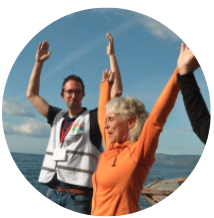Reaching out and helping somebody with symptoms of stress and trauma is something everybody can do, it is not difficult at all. With a tool like the Trauma Tapping Technique it is even easier. Here are some things you may want to think about:
- Learn TTT for yourself first
- Offer, don’t insist
- Agree to continue until calm
- Decide if you will show on yourself or do it on them
- Explain what you will do and how
- Trust the method
If you want to teach others, read our book Trauma Tapping Technique, where this is covered. This is a suggestion for how you can conduct a group training:
1. Introduce the technique as a psychological first aid, and a method to relax the body and the mind. Tell the group about some of the experiences people have described in this book, and your own experiences of using TTT.
2. Show the tapping points on yourself and/or on a drawing, a blackboard or flip chart. The basic material can be downloaded from our website. You can also show the movie Winky and have everybody tap along.
3. Start with a self-tapping by doing the tapping procedure together with the participants. Once this is done, ask one of the participants to lead the tapping, this usually makes the participants more alert.
4. Ask for reactions and comments.
Option – tapping each other
5. Show how to treat another person by asking for a volunteer, often many like to be treated, and remember to use two chairs in parallel to each other as described earlier.
6. Let the participants practice treating each other two by two if they seem to have grasped the method. If they seem unsure ask them to treat each other three by three so they can change between the roles of tapper, being tapped and supervisor. During all the practice go around and assist where assistance is needed.
7. Ask for reactions and comments.
Additional teaching
From this basic training there are innumerable variations. Depending on the time available we also cover as much as possible of the following theoretical topics:
- How we become traumatized
- What are symptoms of traumatic stress
- Traditional and conventional ways of treating trauma
- Attitude, confidence and congruency
- Basic ethics
- Things to consider when treating soldiers and survivors of sexual abuse
- Other relaxation and body awareness exercises
- It is an important part of the learning procedure to let the participants share their knowledge and experiences.
- The Somatic poem
- Ballons for creating playful interaction
- Music for community healing
- The Greeting of Healing
- Blow out
MORE INSPIRATION
- Resolving Yesterday
- Tapping somebody
- Instruction film Winky


